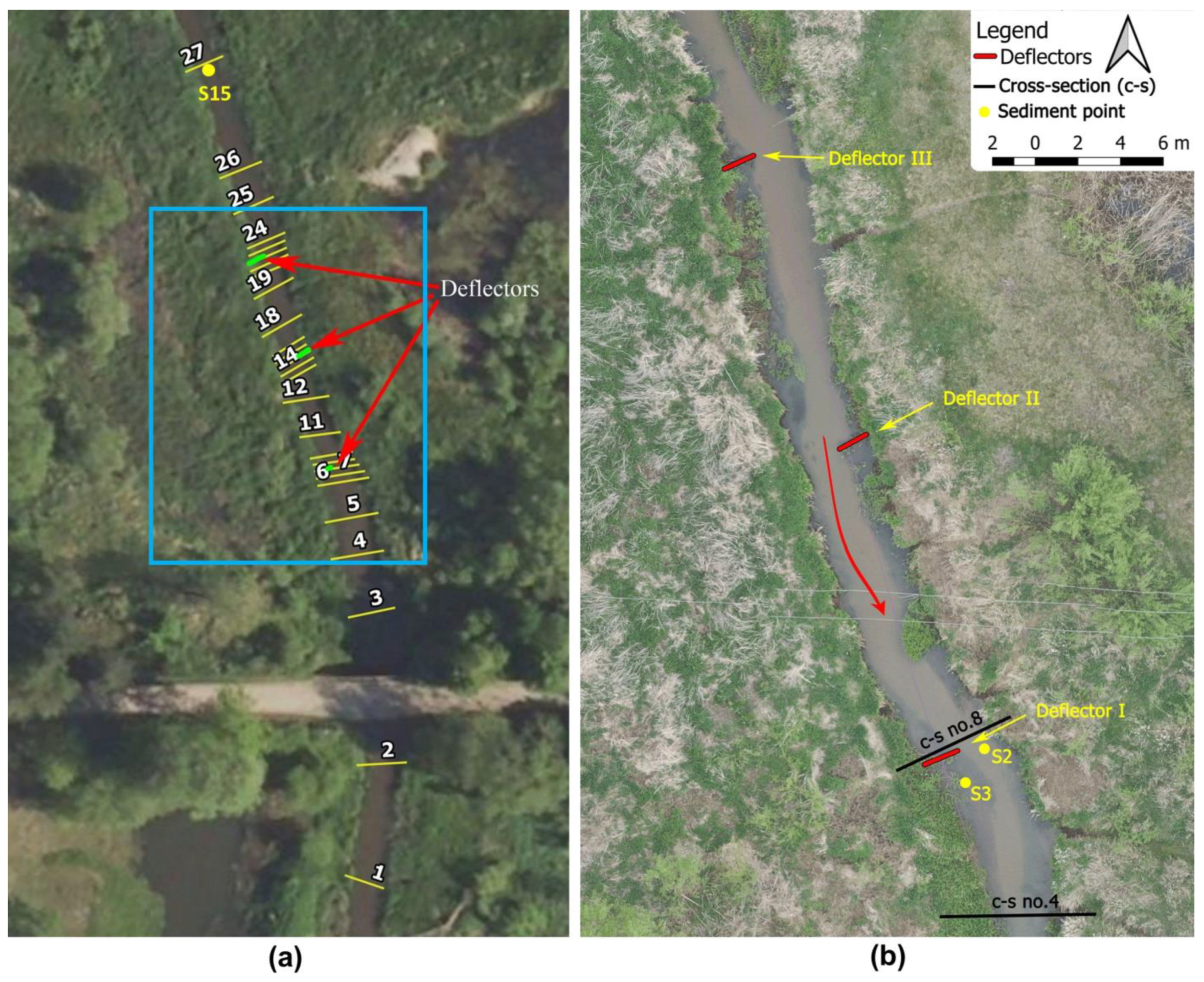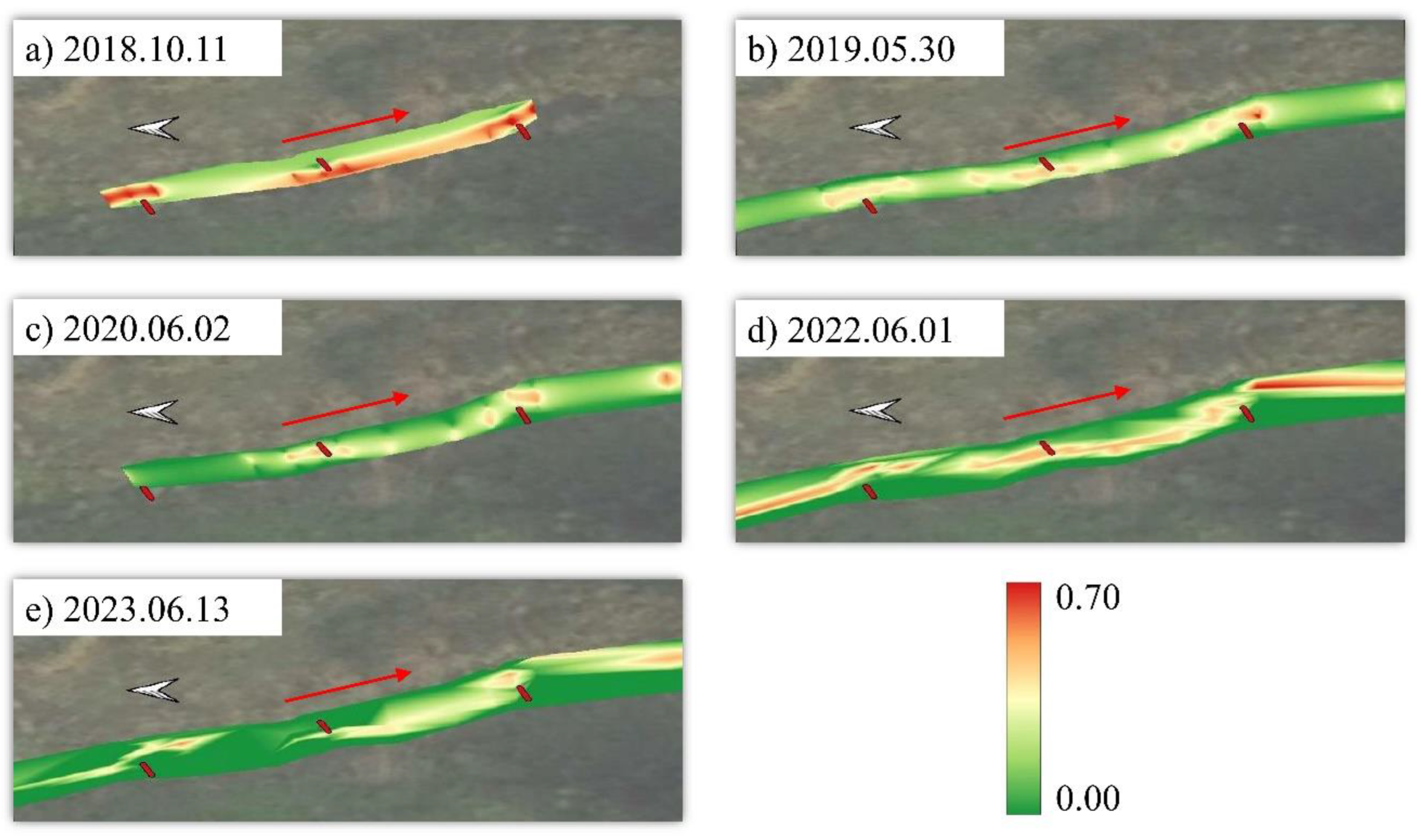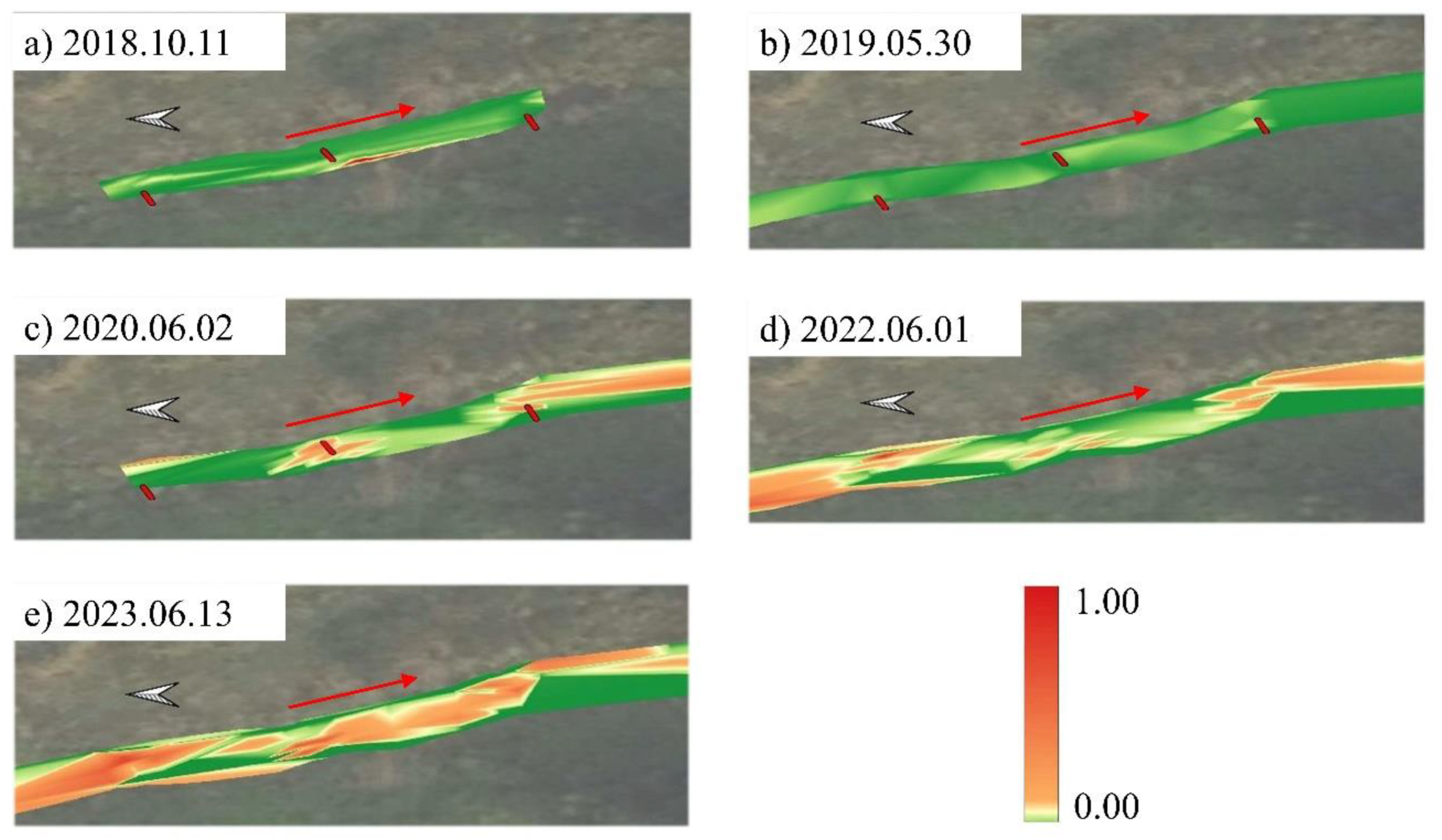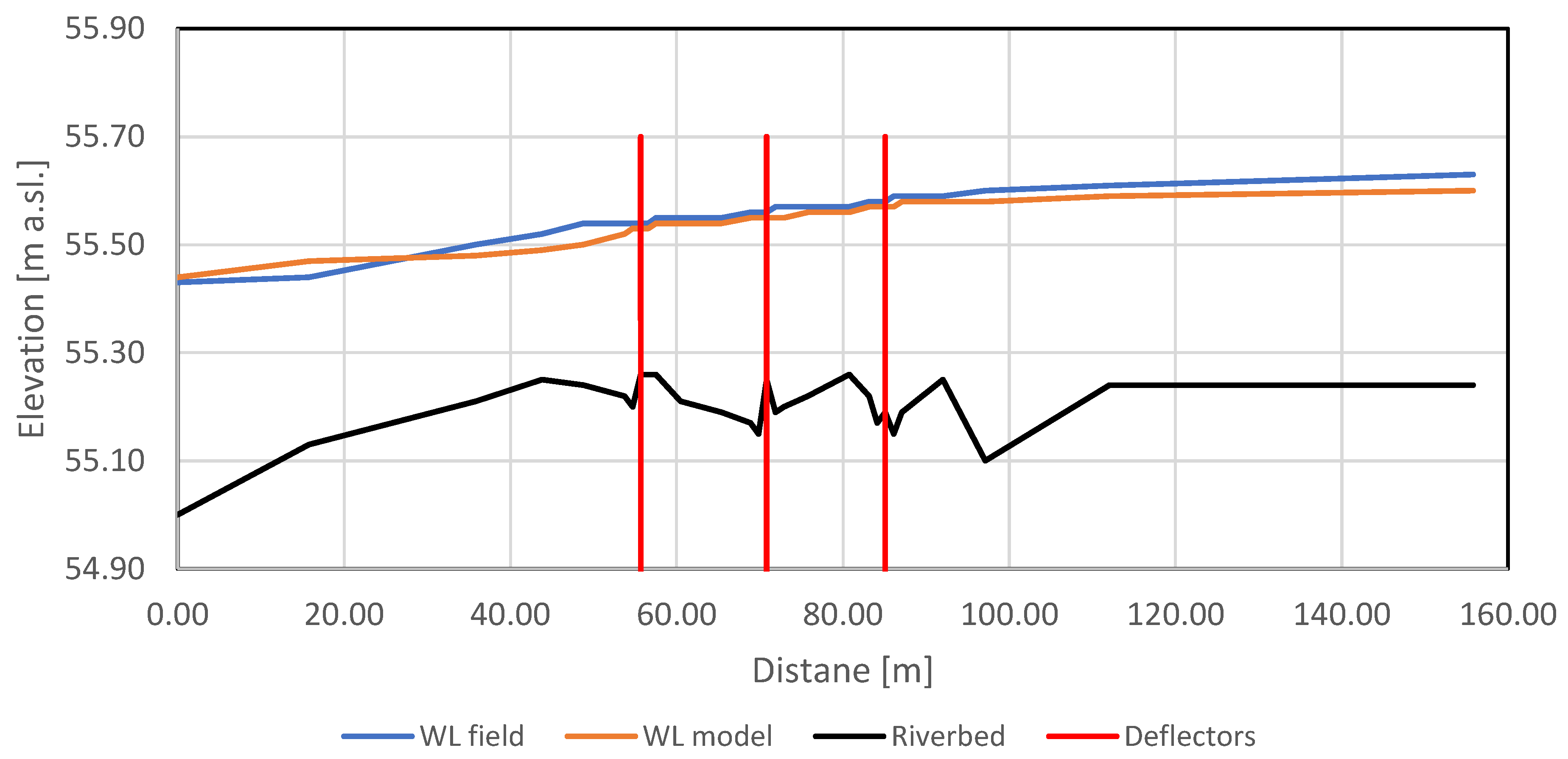Environmental Restoration and Changes of Sediment and Hydrodynamic Parameters in a Section of a Renaturalised Lowland Watercourse
Abstract
1. Introduction
2. Study Area
3. Materials and Methods
3.1. Construction of Deflectors
3.2. Geodetic Surveying
3.3. Hydrometric Measurements
- -
- A set of several instantaneous velocities measured just above the bottom of the stream—V [m s−1];
- -
- h—water depth [m];
- V0.2,0.4,0.8—velocity on 0.2, 0.4, and 0.8 of depth [m·s−1].
3.4. Shear Stresses
- a represents the coefficient of inclination of a straight line adopting the form of equation (where x represents the height above the bottom on which the velocity was measured; b represents the intercept of the equation).
3.5. Changes in Sediment Size
- Sb—volumetric bed load discharge per unit time and channel width [m3·m−1·s−1];
- U—mean velocity in the hydrometric vertical [m·s−1];
- Uc—mean critical velocity in the hydrometric vertical from the Shields criterion [m·s−1];
- h—watercourse depth [m];
- Crb—bed load discharge coefficient [–];
- g—gravitational acceleration [m·s−2];
- ρs—density of sediments [kg·m−3];
- ρw—density of water [kg·m−3];
- Rh—hydraulic radius [m];
- D50—sediment size [m];
- D90—sediment size [m].
3.6. Hydraulic Simulations in HEC-RAS
4. Results
4.1. Geodetic Surveying
4.2. Velocity Distributions
4.3. Shear Stress
4.4. Changes in Sediment Size
4.4.1. Changes Induced by Deflectors
4.4.2. Measurements with the Hydrological Catcher
4.5. Results of Hydraulic Simulations in HEC-RAS
5. Discussion
5.1. Influence of Deflectors on the Hydromorphological Changes
5.2. The Influence of Deflectors on Stream Parameters
5.3. The Impact of Deflectors on the Ecological Conditions of Renaturalised Watercourses
6. Summary
Supplementary Materials
Author Contributions
Funding
Institutional Review Board Statement
Informed Consent Statement
Data Availability Statement
Conflicts of Interest
References
- Hammerling, M.; Walczak, N.; Nowak, A.; Mazur, R.; Chmist, J. Modelling Velocity Distributions and River Bed Changes Using Computer Code SSIIM Below Sills Stabilizing the Riverbed. Pol. J. Environ. Stud. 2019, 28, 1165–1179. [Google Scholar] [CrossRef] [PubMed]
- Wolski, K.; Tymiński, T.; Chrobak, G. Numerical Modeling of the Hydraulic Impact of Riparian Vegetation. E3S Web Conf. 2018, 44, 00194. [Google Scholar] [CrossRef]
- Gilvear, D.J.; Casas-Mulet, R.; Spray, C.J. Trends and Issues in Delivery of Integrated Catchment Scale River Restoration: Lessons Learned from a National River Restoration Survey within Scotland. River Res. Appl. 2012, 28, 234–246. [Google Scholar] [CrossRef]
- Bywater-Reyes, S.; Diehl, R.M.; Wilcox, A.C. The Influence of a Vegetated Bar on Channel-Bend Flow Dynamics. Earth Surf. Dynam. 2018, 6, 487–503. [Google Scholar] [CrossRef]
- Weckwerth, P. Fluvial Responses to the Weichselian Ice Sheet Advances and Retreats: Implications for Understanding River Paleohydrology and Pattern Changes in Central Poland. Int. J. Earth Sci. (Geol. Rundsch.) 2018, 107, 1407–1429. [Google Scholar] [CrossRef]
- Wang, H.; Xu, Z.; Yu, H.; Wang, X. Flow Variability along a Vegetated Natural Stream under Various Sediment Transport Rates. J. Mt. Sci. 2018, 15, 2347–2364. [Google Scholar] [CrossRef]
- Shan, Y.; Liu, X.; Yang, K.; Liu, C. Analytical Model for Stage-Discharge Estimation in Meandering Compound Channels with Submerged Flexible Vegetation. Adv. Water Resour. 2017, 108, 170–183. [Google Scholar] [CrossRef]
- Wolski, K.; Tymiński, T. Studies on the Threshold Density of Phragmites Australis Plant Concentration as a Factor of Hydraulic Interactions in the Riverbed. Ecol. Eng. 2020, 151, 105822. [Google Scholar] [CrossRef]
- Tymiński, T.; Wolski, K. Hydraulic Effect of Vegetation Zones in Open Channels: An Experimental Study of the Distribution of Turbulence. Sustainability 2024, 16, 337. [Google Scholar] [CrossRef]
- Kubrak, E.; Kubrak, J.; Kiczko, A. Experimental Investigation of Kinetic Energy and Momentum Coefficients in Regular Channels with Stiff and Flexible Elements Simulating Submerged Vegetation. Acta Geophys. 2015, 63, 1405–1422. [Google Scholar] [CrossRef]
- Li, Z.; Wang, Z.; Pan, B.; Zhu, H.; Li, W. The Development Mechanism of Gravel Bars in Rivers. Quat. Int. 2014, 336, 73–79. [Google Scholar] [CrossRef]
- Zaborowski, S.; Kałuża, T.; Jusik, S. The Impact of Spontaneous and Induced Restoration on the Hydromorphological Conditions and Macrophytes, Example of Flinta River. Sustainability 2023, 15, 4302. [Google Scholar] [CrossRef]
- Kemp, J.L.; Harper, D.M.; Crosa, G.A. Use of ‘Functional Habitats’ to Link Ecology with Morphology and Hydrology in River Rehabilitation. Aquat. Conserv. Mar. Freshw. Ecosyst. 1999, 9, 159–178. [Google Scholar] [CrossRef]
- Jusik, S.; Szoszkiewicz, K.; Kupiec, J.M.; Lewin, I.; Samecka-Cymerman, A. Development of Comprehensive River Typology Based on Macrophytes in the Mountain-Lowland Gradient of Different Central European Ecoregions. Hydrobiologia 2015, 745, 241–262. [Google Scholar] [CrossRef]
- Available online: https://www.wody.gov.pl/nasze-dzialania/krajowy-program-renaturyzacji-wod-powierzchniowych (accessed on 27 February 2023).
- Woś, A.; Książek, L. Hydrodynamics of the Instream Flow Environment of a Gravel-Bed River. Sustainability 2022, 14, 15330. [Google Scholar] [CrossRef]
- Baar, A.W.; Boechat Albernaz, M.; van Dijk, W.M.; Kleinhans, M.G. Critical Dependence of Morphodynamic Models of Fluvial and Tidal Systems on Empirical Downslope Sediment Transport. Nat. Commun. 2019, 10, 4903. [Google Scholar] [CrossRef]
- Dade, W.B. Grain Size, Sediment Transport and Alluvial Channel Pattern. Geomorphology 2000, 35, 119–126. [Google Scholar] [CrossRef]
- Billi, P.; Demissie, B.; Nyssen, J.; Moges, G.; Fazzini, M. Meander Hydromorphology of Ephemeral Streams: Similarities and Differences with Perennial Rivers. Geomorphology 2018, 319, 35–46. [Google Scholar] [CrossRef]
- Suska, K.; Parasiewicz, P. Application of the Mesohabitat Simulation System (MesoHABSIM) for Assessing Impact of River Maintenance and Restoration Measures. Water 2020, 12, 3356. [Google Scholar] [CrossRef]
- Patil, A.J.; Wang, Z.; He, X.; Li, P.; Yan, T.; Li, H. Understanding the Effect of Environment on Macrobenthic Invertebrate in Naturally Occurring Repeated Mesohabitats from the Warm-Temperate Zone River. Ecohydrol. Hydrobiol. 2023, 23, 66–78. [Google Scholar] [CrossRef]
- European Commission Questions and Answers: EU Biodiversity Strategy for 2030—Bringing Nature Back into Our Lives 2020. Available online: https://environment.ec.europa.eu/strategy/biodiversity-strategy-2030_en (accessed on 2 April 2024).
- Baghalian, S.; Bonakdari, H.; Nazari, F.; Fazli, M. Closed-Form Solution for Flow Field in Curved Channels in Comparison with Experimental and Numerical Analyses and Artificial Neural Network. Eng. Appl. Comput. Fluid Mech. 2012, 6, 514–526. [Google Scholar] [CrossRef]
- Zarrati, A.R.; Tamai, N.; Jin, Y.C. Mathematical Modeling of Meandering Channels with a Generalized Depth Averaged Model. J. Hydraul. Eng. 2005, 131, 467–475. [Google Scholar] [CrossRef]
- Pradhan, A.; Kumar Khatua, K. An Analytical Solution for Flow Estimation of a Meandering Compound Channel. E3S Web Conf. 2018, 40, 06043. [Google Scholar] [CrossRef]
- Kleinhans, M.G.; van den Berg, J.H. River Channel and Bar Patterns Explained and Predicted by an Empirical and a Physics-Based Method. Earth Surf. Process. Landforms 2011, 36, 721–738. [Google Scholar] [CrossRef]
- Eaton, B.C.; Millar, R.G.; Davidson, S. Channel Patterns: Braided, Anabranching, and Single-Thread. Geomorphology 2010, 120, 353–364. [Google Scholar] [CrossRef]
- Liu, X.; Zhou, Q.; Huang, S.; Guo, Y.; Liu, C. Estimation of Flow Direction in Meandering Compound Channels. J. Hydrol. 2018, 556, 143–153. [Google Scholar] [CrossRef]
- Egozi, R.; Ashmore, P. Defining and Measuring Braiding Intensity. Earth Surf. Process. Landforms 2008, 33, 2121–2138. [Google Scholar] [CrossRef]
- Schwenk, J.; Lanzoni, S.; Foufoula-Georgiou, E. The Life of a Meander Bend: Connecting Shape and Dynamics via Analysis of a Numerical Model. J. Geophys. Res. Earth Surf. 2015, 120, 690–710. [Google Scholar] [CrossRef]
- Li, J.; Hoerbinger, S.; Weissteiner, C.; Peng, L.; Rauch, H.P. River Restoration Challenges with a Specific View on Hydromorphology. Front. Struct. Civ. Eng. 2020, 14, 1033–1038. [Google Scholar] [CrossRef]
- Szałkiewicz, E.; Dysarz, T.; Kałuża, T.; Malinger, A.; Radecki-Pawlik, A. Analysis of in-Stream Restoration Structures Impact on Hydraulic Condition and Sedimentation in the Flinta River, Poland. Carpath. J. Earth Environ. Sci. 2019, 14, 275–286. [Google Scholar] [CrossRef]
- Paluch, J. Impact of the Activity of Water Companies Existing in the 19th and Early 20th Centuries in the Area of the River Wełna Basin on the State of Its Hydrography and Water Relations. [In Polish: Wpływ działalności spółek wodnych istniejących w XIX i na początku wieku XX na terenie zlewni rzeki Wełny na stan jej hydrografii i stosunków wodnych. Materiały konferencyjne, Problemy ekologiczne dorzecza rzeki Wełny—stan i kierunki działań]. In Proceedings of the Ecological Problems of the Wełna River Basin-State and Directions of Activities Conference, Wągrowiec, Poland, 2–26 October 2009. [Google Scholar]
- Water Framework Directive (WFD 2000). Directive 2000/60/EC of the European Parliament and of the Council of 23 October 2000 Establishing a Framework for Community Action in the Field of Water Policy. Available online: https://eur-lex.europa.eu/legal-content/en/ALL/?uri=CELEX%3A32000L0060 (accessed on 27 February 2023).
- Pagliara, S.; Kurdistani, S.M. Flume Experiments on Scour Downstream of Wood Stream Restoration Structures. Geomorphology 2017, 279, 141–149. [Google Scholar] [CrossRef]
- Czetwertyński, E.; Szuster, A. Hydrologia i Hydraulika; Wydawnictwa Szkolne i Pedagogiczne: Warszawa, Poland, 1971. [Google Scholar]
- Pasławski, Z. Metody Hydrometrii Rzecznej; Wydawnictwo Komunikacji i Łączności: Warszawa, Poland, 1973. [Google Scholar]
- Bergeron, N.E.; Abrahams, A.D. Estimating Shear Velocity and Roughness Length from Velocity Profiles. Water Resour. Res. 1992, 28, 2155–2158. [Google Scholar] [CrossRef]
- Gordon, N.D. (Ed.) Stream Hydrology: An Introduction for Ecologists, 2nd ed.; Wiley: Chichester, UK; Hoboken, NJ, USA, 2004; ISBN 978-0-470-84357-4. [Google Scholar]
- PN-EN ISO 17892-4:2017-01; Geotechnical Investigation and Testing—Laboratory Testing of Soils—Part 4: Testing of Soil Granulation. Polish Committee for Standarization: Warsaw, Poland, 2017.
- Przedwojski, B. Morfologia Rzek i Prognozowanie Procesów Rzecznych; Wydawnictwo Akademii Rolniczej im. Augusta Cieszkowskiego: Poznań, Poland, 1998; ISBN 83-7160-101-8. [Google Scholar]
- Brandimarte, L.; Di Baldassarre, G. Uncertainty in Design Flood Profiles Derived by Hydraulic Modelling. Hydrol. Res. 2012, 43, 753–761. [Google Scholar] [CrossRef]
- Gibson, S.; Comport, B.; Corum, Z. Calibrating a Sediment Transport Model through a Gravel-Sand Transition: Avoiding Equifinality Errors in HEC-RAS Models of the Puyallup and White Rivers. In Proceedings of the World Environmental and Water Resources Congress 2017, Sacramento, CA, USA, 21–25 May 2017; pp. 179–191. [Google Scholar]
- USACE. HEC-RAS River Analysis System User’s Manual Version 6.0; Report No. CPD-68; US Army Corps of Engineers Hydrologic Engineering Center: Davis, CA, USA, 2020.
- Peker, İ.B.; Gülbaz, S.; Demir, V.; Orhan, O.; Beden, N. Integration of HEC-RAS and HEC-HMS with GIS in Flood Modeling and Flood Hazard Mapping. Sustainability 2024, 16, 1226. [Google Scholar] [CrossRef]
- Zaborowski, S.; Kałuża, T.; Rybacki, M.; Radecki-Pawlik, A. Influence of River Channel Deflector Hydraulic Structures on Lowland River Roughness Coefficient Values: The Flinta River, Wielkopolska Province, Poland. Ecohydrol. Hydrobiol. 2023, 23, 79–97. [Google Scholar] [CrossRef]
- Radtke, G. Restoration of the Trzebiocha River as One of the Elements of Protection of Lake Trout from Lake Wdzydze. Komunikaty Rybackie IRŚ 1944, 1, 22–23. [Google Scholar]
- Świergocka, M.; Połoński, P. “Demelioration” in the Catchment Area of the Rivers Wda and Trzebiocha (Wdzydze Landscape Park). Przegląd Przyr. 1996, 7, 3–4. [Google Scholar]
- Obolewski, K.; Osadowski, Z.; Miller, M. Sposoby Renaturyzacji Małych Cieków Na Przykładzie Rzeki Kwaczy (Dolina Słupi). Nauka Przyroda Technologie 2009, 3, #95. [Google Scholar]
- Obolewski, K. Krótkoterminowe Ekologiczne Efekty Renaturyzacji Niewielkich Rzek Nizinnych Na Przykładzie Rzeki Kwaczy; Park Krajobrazowy “Dolina Słupi”, Akademia Pomorska w Słupsku: Słupsk, Poland, 2009. [Google Scholar]
- Biron, P.M.; Robson, C.; Lapointe, M.F.; Gaskin, S.J. Three-dimensional Flow Dynamics around Deflectors. River Res. Appl. 2005, 21, 961–975. [Google Scholar] [CrossRef]
- Elkins, E.M.; Pasternack, G.B.; Merz, J.E. Use of Slope Creation for Rehabilitating Incised, Regulated, Gravel Bed Rivers. Water Resour. Res. 2007, 43, 2006WR005159. [Google Scholar] [CrossRef]
- Rana, S.M.M.; Scott, D.T.; Hester, E.T. Effects of In-Stream Structures and Channel Flow Rate Variation on Transient Storage. J. Hydrol. 2017, 548, 157–169. [Google Scholar] [CrossRef]
- Yi, Y.; Cheng, X.; Wieprecht, S.; Tang, C. Comparison of Habitat Suitability Models Using Different Habitat Suitability Evaluation Methods. Ecol. Eng. 2014, 71, 335–345. [Google Scholar] [CrossRef]
- Radspinner, R.R.; Diplas, P.; Lightbody, A.F.; Sotiropoulos, F. River Training and Ecological Enhancement Potential Using In-Stream Structures. J. Hydraul. Eng. 2010, 136, 967–980. [Google Scholar] [CrossRef]
- Zhou, T.; Endreny, T. Meander Hydrodynamics Initiated by River Restoration Deflectors. Hydrol. Process. 2012, 26, 3378–3392. [Google Scholar] [CrossRef]
- Kujanova, K.; Matouskova, V. Improvement in Physical River Habitat Quality in Response to River Restoration Measures. Geografie 2016, 121, 54–78. [Google Scholar] [CrossRef]
- Kałuża, T.; Radecki-Pawlik, A.; Szoszkiewicz, K.; Plesiński, K.; Radecki-Pawlik, B.; Laks, I. Plant Basket Hydraulic Structures (PBHS) as a New River Restoration Measure. Sci. Total Environ. 2018, 627, 245–255. [Google Scholar] [CrossRef]
- Biron, P.M.; Carver, R.B.; Carré, D.M. Sediment Transport and Flow Dynamics Around a Restored Pool in a Fish Habitat Rehabilitation Project: Field and 3d Numerical Modelling Experiments. River Res. Appl. 2012, 28, 926–939. [Google Scholar] [CrossRef]
- Brotherton, D.I. On the Origin and Characteristics of River Channel Patterns. J. Hydrol. 1979, 44, 211–230. [Google Scholar] [CrossRef]
- Bahrami Yarahmadi, M.; Shafai Bejestan, M.; Pagliara, S. An Experimental Study on the Secondary Flows and Bed Shear Stress at a 90-Degree Mild Bend with and without Triangular Vanes. J. Hydro-Environ. Res. 2020, 33, 1–9. [Google Scholar] [CrossRef]
- Kasperek, R.; Rosik-Dulewska, C.; Wiatkowski, M. Studies of bottom sediments in the border meanders of upper Odra river. Environ. Protec. Yearb. 2007, 9, 293–302. Available online: https://yadda.icm.edu.pl/baztech/element/bwmeta1.element.baztech-article-BPW8-0009-0072 (accessed on 26 October 2022). (In Polish).
- Wang, Y.; Wai, O.W.H.; Chen, Q. Laboratory Study on Fish Behavioral Response to Meandering Flow and Riffle-Pool Sequence Driven by Deflectors in Straight Concrete Flood Channels. J. Hydrol. 2021, 598, 125736. [Google Scholar] [CrossRef]
- Rapant, D. Physical Modeling of Deflector Arms in a River Table; SUNY College of Environmental Science and Forestry: Syracuse, NY, USA, 2012. [Google Scholar]
- Kail, J.; Hering, D.; Muhar, S.; Gerhard, M.; Preis, S. The Use of Large Wood in Stream Restoration: Experiences from 50 Projects in Germany and Austria. J. Appl. Ecol. 2007, 44, 1145–1155. [Google Scholar] [CrossRef]
- Bednarczyk, S.; Duszyński, R. Hydrauliczne i Hydrotechniczne Podstawy Regulacji i Rewitalizacji Rzek; Wydawnictwo Politechniki: Gdańskiej, Poland, 2008; ISBN 83-7348-212-1. [Google Scholar]
- Prus, P.; Popek, Z.; Pawlaczyk, P. (Eds.) Good River Maintenance Practices; Wydanie II, poprawione i uzupełnione; WWF Polska: Warszawa, Poland, 2018; ISBN 978-83-62069-49-1. [Google Scholar]
- Hill, G.; Maddock, I.; Bickerton, M. Testing the Relationship Between Surface Flow Types and Benthic Macroinvertebrates. In Ecohydraulics; Maddock, I., Harby, A., Kemp, P., Wood, P., Eds.; Wiley: Hoboken, NJ, USA, 2013; pp. 213–228. ISBN 978-0-470-97600-5. [Google Scholar]
- Szałkiewicz, E.; Kałuża, T.; Grygoruk, M. Environmental Flows Assessment for Macroinvertebrates at the River Reach Scale in Different Degrees of Hydromorphological Alteration. Front. Environ. Sci. 2022, 10, 866526. [Google Scholar] [CrossRef]
- Heggenes, J.; Wollebæk, J. Habitat Use and Selection by Brown Trout in Streams. In Ecohydraulics; Maddock, I., Harby, A., Kemp, P., Wood, P., Eds.; Wiley: Hoboken, NJ, USA, 2013; pp. 157–176. ISBN 978-0-470-97600-5. [Google Scholar]
- Crisp, D.T. (Ed.) Trout and Salmon: Ecology, Conservation and Rehabilitation, 1st ed.; Wiley: Hoboken, NJ, USA, 2000; ISBN 978-0-85238-256-1. [Google Scholar]
- Janauer, G.A.; Schmidt-Mumm, U.; Reckendorfer, W. Ecohydraulics and Aquatic Macrophytes: Assessing the Relationship in River Floodplains. In Ecohydraulics; Maddock, I., Harby, A., Kemp, P., Wood, P., Eds.; Wiley: Hoboken, NJ, USA, 2013; pp. 245–259. ISBN 978-0-470-97600-5. [Google Scholar]
- Neuhäusl, R. Die Pflanzengesellschaften Des Südöstlichen Teiles Des Wittingauer Beckens. Preslia 1959, 31, 115–147. [Google Scholar]
- Gebler, D.; Zalewska-Gałosz, J.; Jopek, M.; Szoszkiewicz, K. Molecular Identification and Habitat Requirements of the Hybrid Ranunculus circinatus × R. Fluitans and Its Parental Taxa R. circinatus and R. fluitans in Running Waters. Hydrobiologia 2022, 849, 2999–3014. [Google Scholar] [CrossRef]
- Marciniak, M.; Gebler, D.; Grygoruk, M.; Zalewska-Gałosz, J.; Szoszkiewicz, K. Hyporheic Flow in Aquatic Ranunculus Habitats in Temperate Lowland Rivers in Central Europe. Ecol. Indic. 2023, 153, 110422. [Google Scholar] [CrossRef]
- Liu, C.; Shan, Y.; Liu, X.; Yang, K. Method for Assessing Discharge in Meandering Compound Channels. Proc. Inst. Civ. Eng. Water Manag. 2016, 169, 17–29. [Google Scholar] [CrossRef]
- Tambroni, N.; Luchi, R.; Seminara, G. Can Tide Dominance Be Inferred from the Point Bar Pattern of Tidal Meandering Channels? J. Geophys. Res. Earth Surf. 2017, 122, 492–512. [Google Scholar] [CrossRef]
- Duan, J.G.; Julien, P.Y. Numerical Simulation of Meandering Evolution. J. Hydrol. 2010, 391, 34–46. [Google Scholar] [CrossRef]
- Czuba, J.A.; David, S.R.; Edmonds, D.A.; Ward, A.S. Dynamics of Surface-Water Connectivity in a Low-Gradient Meandering River Floodplain. Water Resour. Res. 2019, 55, 1849–1870. [Google Scholar] [CrossRef]











| Characteristic Flows [m3·s−1] | ||||||||
|---|---|---|---|---|---|---|---|---|
| NNQ | SNQ | WNQ | NSQ | SSQ | WSQ | NWQ | SWQ | WWQ |
| 0.01 | 0.10 | 0.41 | 0.24 | 0.66 | 1.72 | 0.77 | 3.26 | 7.28 |
| Date | 11 October 2018 | 30 May 2019 | 2 June 2020 | 1 June 2022 | 13 June 2023 |
|---|---|---|---|---|---|
| Discharge [m3∙s−1] | 0.198 | 0.207 | 0.180 | 0.223 | 0.203 |
| Date | Tangential Stresses [N∙m−2] | |||||||
|---|---|---|---|---|---|---|---|---|
| I | II | III | IV | V | VI | VII | VIII | |
| 2018.10.11 | 0.0098 | 0.0011 | 0.0371 | 0.0385 | 0.0385 | 0.0302 | 0.0039 | - |
| 2019.05.30 | 0.2094 | 1.0396 | 0.0227 | 0.0013 | 0.0534 | 0.0648 | 0.0350 | - |
| 2020.06.02 | 0.4319 | 0.0220 | 0.1461 | 0.0410 | 0.0392 | 0.0000 | 0.0827 | 0.0337 |
| 2022.06.01 | 0,0137 | 0.1921 | 0.3128 | 0.0002 | 0.0753 | 0.1916 | 0.0167 | - |
| 2023.06.13 | 0.0629 | 0.7201 | 0.0308 | 0.5025 | 0.2428 | 0.3104 | 1.7772 | - |
| No. | Q | v | h | Rh | Crb | Uc | Sb | qr | M |
|---|---|---|---|---|---|---|---|---|---|
| [-] | [m3∙s−1] | [m∙s−1] | [m] | [m] | [-] | [m∙s−1] | [m3∙m−1∙s−1] | [kg∙m−1∙s−1] | [Mg∙Year−1] |
| 1 | 0.109 | 0.137 | 0.245 | 0.231 | 0.0050 | 1.226 × 10−5 | 3.020 × 10−8 | 8.003 × 10−5 | 2.524 |
| 2 | 0.164 | 0.200 | 0.328 | 0.287 | 0.0050 | 1.273 × 10−5 | 9.839 × 10−8 | 2.607 × 10−4 | 8.222 |
| 3 | 0.203 | 0.170 | 0.451 | 0.354 | 0.0050 | 1.319 × 10−5 | 5.068 × 10−8 | 1.343 × 10−4 | 4.235 |
| 4 | 0.309 | 0.222 | 0.410 | 0.342 | 0.0050 | 1.312 × 10−5 | 1.294 × 10−7 | 3.430 × 10−4 | 10.817 |
| 5 | 0.625 | 0.341 | 0.471 | 0.419 | 0.0050 | 1.356 × 10−5 | 5.300 × 10−7 | 1.404 × 10−3 | 44.291 |
Disclaimer/Publisher’s Note: The statements, opinions and data contained in all publications are solely those of the individual author(s) and contributor(s) and not of MDPI and/or the editor(s). MDPI and/or the editor(s) disclaim responsibility for any injury to people or property resulting from any ideas, methods, instructions or products referred to in the content. |
© 2024 by the authors. Licensee MDPI, Basel, Switzerland. This article is an open access article distributed under the terms and conditions of the Creative Commons Attribution (CC BY) license (https://creativecommons.org/licenses/by/4.0/).
Share and Cite
Zaborowski, S.; Kałuża, T.; Jusik, S.; Dysarz, T.; Hämmerling, M. Environmental Restoration and Changes of Sediment and Hydrodynamic Parameters in a Section of a Renaturalised Lowland Watercourse. Sustainability 2024, 16, 3948. https://doi.org/10.3390/su16103948
Zaborowski S, Kałuża T, Jusik S, Dysarz T, Hämmerling M. Environmental Restoration and Changes of Sediment and Hydrodynamic Parameters in a Section of a Renaturalised Lowland Watercourse. Sustainability. 2024; 16(10):3948. https://doi.org/10.3390/su16103948
Chicago/Turabian StyleZaborowski, Stanisław, Tomasz Kałuża, Szymon Jusik, Tomasz Dysarz, and Mateusz Hämmerling. 2024. "Environmental Restoration and Changes of Sediment and Hydrodynamic Parameters in a Section of a Renaturalised Lowland Watercourse" Sustainability 16, no. 10: 3948. https://doi.org/10.3390/su16103948
APA StyleZaborowski, S., Kałuża, T., Jusik, S., Dysarz, T., & Hämmerling, M. (2024). Environmental Restoration and Changes of Sediment and Hydrodynamic Parameters in a Section of a Renaturalised Lowland Watercourse. Sustainability, 16(10), 3948. https://doi.org/10.3390/su16103948







